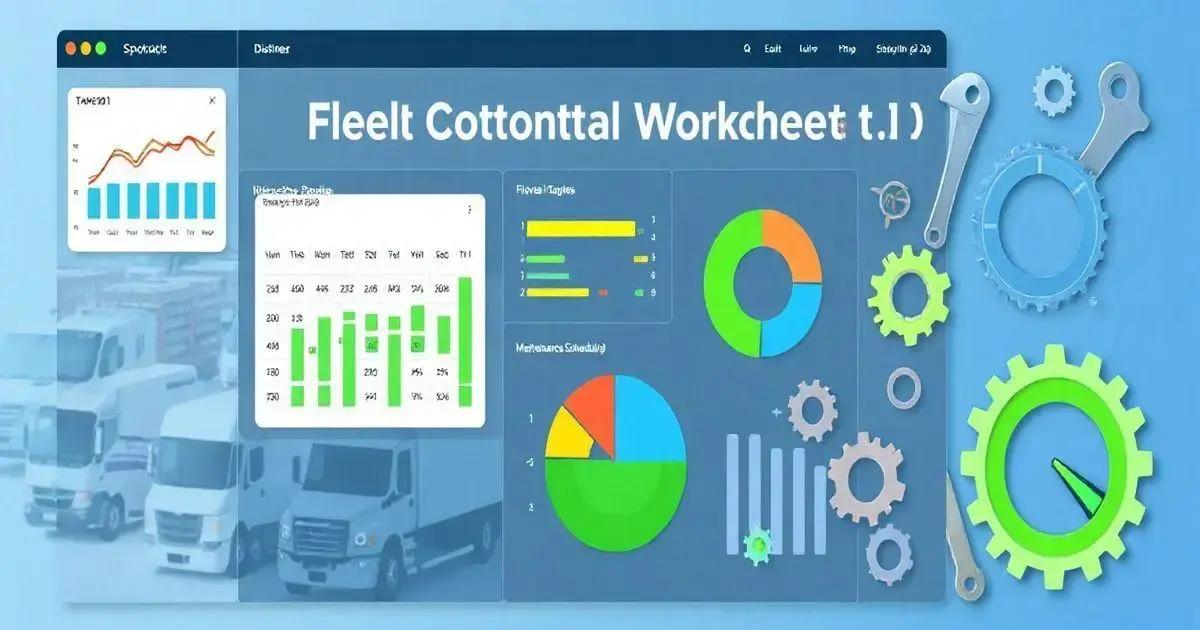Fleet Control Worksheet 7.0: Optimize Your Fleet Management Leave a comment
The Fleet Control Worksheet 7.0 is an advanced Excel template that enhances fleet management through features like initial dashboards for performance metrics, registration tracking for compliance, document management for legal adherence, travel control for resource optimization, tire management for maintenance scheduling, and comprehensive maintenance procedures to ensure vehicle reliability and safety.
The Fleet Control Worksheet 7.0 is a comprehensive template designed for effective fleet management.
This worksheet offers essential features such as travel tracking, maintenance scheduling, and cost analysis, making it an invaluable tool for logistics and operational efficiency.
Initial Dashboards Overview
The Fleet Control Worksheet 7.0 provides an intuitive dashboard that gives a quick overview of key metrics crucial for managing your fleet effectively. This dashboard is designed to streamline your operations by presenting essential data in a user-friendly format.
Key features of the initial dashboard include:
- KM by Driver: Track the total kilometers driven by each driver, helping to identify performance patterns and areas for improvement.
- KM per Vehicle: Monitor the distance traveled by each vehicle, which is critical for assessing vehicle usage and scheduling maintenance.
- KM per Liter: Analyze fuel efficiency by calculating kilometers driven per liter of fuel consumed, aiding in effective fuel management.
- KM per Trip: Evaluate the efficiency of trips taken, ensuring that routes are optimized for performance and cost-effectiveness.
- Average Consumption per Vehicle: Calculate the average fuel consumption for each vehicle to identify any that may require maintenance or operational changes.
- Average Consumption per Driver: Assess fuel consumption patterns per driver, enabling targeted training or adjustments to driving habits.
- Total General, Preventive and Corrective Maintenance: Keep track of all maintenance performed on the fleet, ensuring safety and reliability.
- Maintenance Cost Average: Monitor the average cost associated with maintenance to help budget effectively and plan for future expenses.
- Total cost of Mechanical and Electrical Maintenance: Provide insight into the expenses related to mechanical and electrical repairs, enabling better financial planning.
- Total Tire Maintenance Cost: Track tire-related expenses to understand the total cost of ownership for each vehicle.
- Total Lubricant Cost: Calculate costs associated with lubricants used in fleet maintenance, which is essential for budgeting.
- Average cost of Mechanical and Electrical Maintenance: Determine the average cost for repairs, allowing for more accurate financial forecasting.
- Average Tire Maintenance Cost: Monitor average costs related to tire maintenance to identify potential savings opportunities.
- Average cost with Lubricants: Assess lubricant costs to ensure proper budgeting and identify areas for cost reduction.
- Vehicles in Transit: Keep track of the vehicles currently in transit, enabling better oversight and scheduling.
- Tires in Transit: Monitor the status of tires, ensuring proper inventory management and availability.
- Delayed Vehicle Documents: Identify any vehicles with outstanding documentation, enabling proactive management.
- Delayed Driver Documents: Keep track of driver documentation to ensure compliance and safety.
- Delayed Preventive Maintenance: Monitor preventive maintenance schedules to avoid costly breakdowns and ensure vehicle safety.
- Total Cost Versus Shipping: Evaluate the total costs associated with the fleet against shipping revenues to assess profitability.
- Fuel, Maintenance and Other Costs: Comprehensive analysis of all costs associated with fleet operations to enable better financial management.
This Initial Dashboards Overview serves as a critical tool for fleet managers, providing the insights needed to enhance operational efficiency and reduce costs.

Registration Details
The Fleet Control Worksheet 7.0 includes a comprehensive registration section designed to effectively manage all necessary details related to drivers and vehicles. Proper registration is essential for maintaining accurate records and ensuring the efficient operation of your fleet.
This section allows you to register the following:
- Driver Registration: Capture essential information about each driver, including their name, contact information, and license details. This helps in managing driver assignments and ensures compliance with legal requirements.
- Vehicle Type Registration: Document the various types of vehicles in your fleet, including make, model, and year. This categorization is crucial for effective maintenance scheduling and performance analysis.
- Mechanical and Electrical Services Registry: Keep a record of all mechanical and electrical services performed on each vehicle. This information is vital for tracking service history and identifying recurring issues.
- Tree Service Registration: Register details about any tree services associated with your fleet, particularly if your operations involve transportation for landscaping or similar services.
- Lubricant Services Register: Document the lubricants used for each vehicle to ensure proper maintenance and to monitor overall costs associated with lubricant consumption.
- Register of Workshops and Suppliers: Maintain a list of workshops and suppliers used for servicing and parts. This aids in quick access for repairs and ensures continuity in service quality.
- Expenditure Type Register: Categorize and register different types of expenditures associated with the fleet, such as fuel, maintenance, and operational costs. This helps in managing budgets effectively and analyzing cost efficiency.
- Refueling Station Registration: Record details of preferred refueling stations for your fleet. This is important for planning fuel purchases and ensuring drivers know where to refuel efficiently.
- Fuel Type Register: Document the types of fuel used by each vehicle, which is essential for managing fuel costs and ensuring compliance with environmental regulations.
The Registration Details section of the Fleet Control Worksheet 7.0 not only helps in maintaining an organized record of drivers and vehicles but also supports compliance, safety, and efficiency across fleet operations.
Document Management Essentials
Effective document management is a critical aspect of the Fleet Control Worksheet 7.0. This section is designed to help fleet managers maintain and track all important documents associated with drivers and vehicles, ensuring compliance and operational efficiency.
The Document Management Essentials include the following key components:
- Driver Document Control: This feature allows you to manage all documents related to each driver, such as licenses, certifications, and training records. Keeping these documents organized and up-to-date is crucial for ensuring that all drivers meet legal and safety requirements.
- Vehicle Document Control: Similar to driver documentation, this component enables you to track all necessary documents for each vehicle in your fleet. This includes registration papers, insurance documents, and inspection reports. By having these records readily accessible, you can avoid potential compliance issues and ensure that all vehicles are legally operational.
Additionally, the Document Management Essentials provide reminders for document renewals and expirations, helping fleet managers stay proactive in maintaining compliance. This feature minimizes the risk of penalties or operational disruptions due to expired licenses or unregistered vehicles.
With effective document management, fleet managers can focus more on operational efficiency and less on administrative burdens, ultimately leading to smoother operations and enhanced safety for all drivers and vehicles.

Travel Control Features
The Fleet Control Worksheet 7.0 includes robust travel control features designed to streamline the management of trips, ensuring optimal efficiency and cost-effectiveness in fleet operations.
Key travel control features encompass the following:
Travel Control Features
- Cargo Control Linked to Trips: This feature allows fleet managers to associate specific cargo with each trip taken. By tracking cargo movements, you can ensure accountability and monitor delivery statuses effectively.
- Vehicle Control: Monitor which vehicle is assigned to each trip, optimizing vehicle usage and maintenance scheduling. This ensures that each vehicle operates within its capacity and that no vehicle is overused or neglected.
- Driver Control: Track the drivers assigned to each trip, enabling better management of driver schedules and responsibilities. This feature helps in assessing driver performance and ensures compliance with driving hours regulations.
- Supply Control: Manage supplies needed for each trip, including fuel, maintenance materials, and any cargo-specific requirements. This ensures that all necessary supplies are ready before departure, preventing delays during transit.
- Control of All Travel Expenses: Keep an accurate record of all costs associated with travel, including fuel, tolls, and maintenance. This feature assists in analyzing travel expenses against budgets and identifying opportunities for cost savings.
By incorporating these travel control features, the Fleet Control Worksheet 7.0 enhances visibility and accountability within fleet operations. Fleet managers can make data-driven decisions, improving overall efficiency and ensuring that all trips are executed smoothly and effectively.
Tire Control Management
The Fleet Control Worksheet 7.0 offers a comprehensive tire control management system aimed at ensuring the safety and efficiency of vehicles in your fleet. Proper tire management is crucial for reducing costs, maintaining vehicle performance, and extending the life of tires.
The Tire Control Management includes the following essential features:
Features
- Identification for Each Tire: Maintain detailed records for each tire in your fleet, including brand, size, tread depth, and date of purchase. This allows for easy tracking of tire conditions and performance over time.
- Tire Change Schedule by KM: Set up a schedule for tire changes based on the distance traveled by each vehicle. This proactive approach helps to prevent tire-related issues and ensures that tires are replaced before they reach the end of their usable life.
- Signal of How Much KM is Left to Change the Tire: Use built-in alerts to indicate the remaining kilometers before a tire should be changed. This feature helps fleet managers stay ahead of tire replacements and avoid unexpected breakdowns.
- Status per Action: Track the current status of each tire, including actions such as allocation to a vehicle, removal from a vehicle, maintenance, or scrapping. This feature ensures that all tire-related actions are recorded, providing a complete picture of tire inventory and usage.
With these tire control management features in the Fleet Control Worksheet 7.0, fleet managers can enhance safety, reduce operational costs, and ensure compliance with maintenance schedules. Proper tire management not only improves vehicle performance but also contributes to environmental sustainability by minimizing waste.

Maintenance Control Procedures
The Fleet Control Worksheet 7.0 features a detailed maintenance control procedures section designed to keep your fleet in top condition while minimizing downtime and repair costs. Effective maintenance management is essential for optimizing fleet performance and ensuring driver safety.
This section covers the following critical maintenance control procedures:
- Corrective and Preventive Maintenance Type: Track both corrective maintenance (reactive measures taken after an issue arises) and preventive maintenance (scheduled services performed to prevent issues). This approach helps maintain a proactive stance on fleet management.
- Maintenance by Vehicle: Record all maintenance activities performed on each vehicle, including oil changes, tire rotations, and inspections. Keeping detailed logs helps in identifying trends and recurring issues specific to each vehicle.
- Maintenance by Mechanical and Electrical Type, Tire and Lubricants: Categorize maintenance tasks based on their nature—mechanical or electrical systems, tires, and lubricants. This categorization allows for more focused tracking and management of specific maintenance needs.
- Maintenance Cost: Monitor all costs associated with maintenance activities, providing insights into budget allocation and identifying areas where costs may be reduced. This feature aids in financial planning and resource allocation.
- Preventive Maintenance Schedule: Set up a scheduled maintenance calendar to ensure that all vehicles receive regular inspections and servicing. This systematic approach helps prevent unexpected breakdowns and prolongs vehicle life.
- Preventive Maintenance Signal: Utilize alerts to remind fleet managers of upcoming preventive maintenance due dates. This feature ensures that maintenance tasks are not overlooked and that vehicles remain in optimal condition.
- Status by: Categorize maintenance tasks as scheduled, accomplished, or delayed. This organization helps in tracking the effectiveness of maintenance procedures and ensuring compliance with set schedules.
By implementing these maintenance control procedures in the Fleet Control Worksheet 7.0, fleet managers can significantly improve vehicle reliability and safety, reduce overall operational costs, and enhance the efficiency of their fleet management processes.
Conclusion
In summary, the Fleet Control Worksheet 7.0 is a powerful tool designed to enhance the management of fleet operations.
With features like travel control, tire management, and comprehensive maintenance procedures, this worksheet provides fleet managers with the insights and organization necessary to optimize performance and reduce costs.
By effectively monitoring critical aspects such as driver and vehicle registrations, documentation, and maintenance schedules, your fleet can operate more efficiently and safely.
The structured data presented in the dashboards enables informed decision-making, ultimately leading to improved operational outcomes.
Investing in the Fleet Control Worksheet 7.0 not only streamlines processes but also fosters a proactive approach to fleet management, ensuring that your vehicles and drivers are always ready for the road.
Frequently Asked Questions about Fleet Control Worksheet 7.0
What is the Fleet Control Worksheet 7.0?
The Fleet Control Worksheet 7.0 is a comprehensive Excel template designed for effective fleet management, enabling users to track vehicles, drivers, maintenance, and costs.
How can I benefit from using the Fleet Control Worksheet 7.0?
Using the worksheet helps streamline fleet operations, improve maintenance scheduling, monitor fuel consumption, and manage overall operational costs effectively.
Is the Fleet Control Worksheet compatible with all versions of Excel?
Yes, the Fleet Control Worksheet 7.0 is compatible with various versions of Excel, including 2007, 2010, 2013, and 2016.
Can I customize the worksheet to fit my specific fleet requirements?
Yes, the worksheet can be customized to meet your specific needs, allowing you to add or modify sections as required.
What types of maintenance can I track with the worksheet?
You can track both corrective and preventive maintenance, as well as specific maintenance tasks related to mechanical, electrical systems, tires, and lubricants.
How do I get support if I have issues with the worksheet?
Support is available via email or WhatsApp during business hours. Assistance with any technical issues or questions regarding the worksheet is provided free of charge.

